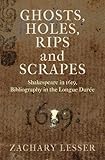Ghosts, Holes, Rips and Scrapes : Shakespeare in 1619, Bibliography in the Longue Durée / Zachary Lesser.
Material type: TextSeries: Published in cooperation with Folger Shakespeare LibraryPublisher: Philadelphia : University of Pennsylvania Press, [2021]Copyright date: ©2021Description: 1 online resource (232 p.) : 70 color imgs and 1 tableContent type:
TextSeries: Published in cooperation with Folger Shakespeare LibraryPublisher: Philadelphia : University of Pennsylvania Press, [2021]Copyright date: ©2021Description: 1 online resource (232 p.) : 70 color imgs and 1 tableContent type: - 9780812297928
- History-Medieval 500 to 1500
- Literature (Scholarly)
- LITERARY CRITICISM / Shakespeare
- 17th seventeenth century English literature
- A.W. Pollard
- Authorship
- British literary criticism
- Early Modern Rare Book Manuscript
- False Folio
- First Folio
- History of the book
- Jaggard Quarto
- New Bibliography Research Methodology
- Shakespeare Bibliography
- Shakespeare Pavier Quartos
- Shakespeare drama plays
- W.W. Greg
- antiquarian rare books
- books about books
- bookselling
- forgers
- printing publishing history
- 822.3/3 23
- PR3071 .L47 2021eb
- online - DeGruyter
| Item type | Current library | Call number | URL | Status | Notes | Barcode | |
|---|---|---|---|---|---|---|---|
 eBook
eBook
|
Biblioteca "Angelicum" Pont. Univ. S.Tommaso d'Aquino Nuvola online | online - DeGruyter (Browse shelf(Opens below)) | Online access | Not for loan (Accesso limitato) | Accesso per gli utenti autorizzati / Access for authorized users | (dgr)9780812297928 |
Browsing Biblioteca "Angelicum" Pont. Univ. S.Tommaso d'Aquino shelves, Shelving location: Nuvola online Close shelf browser (Hides shelf browser)

|

|

|

|

|

|

|
||
| online - DeGruyter Fighting for the Higher Law : Black and White Transcendentalists Against Slavery / | online - DeGruyter Star Territory : Printing the Universe in Nineteenth-Century America / | online - DeGruyter The Belief in Intuition : Individuality and Authority in Henri Bergson and Max Scheler / | online - DeGruyter Ghosts, Holes, Rips and Scrapes : Shakespeare in 1619, Bibliography in the Longue Durée / | online - DeGruyter Jews and Journeys : Travel and the Performance of Jewish Identity / | online - DeGruyter Violence and Power in the Thought of Hannah Arendt / | online - DeGruyter Battle Green Vietnam : The 1971 March on Concord, Lexington, and Boston / |
Frontmatter -- Contents -- Acknowledgments -- Introduction -- Chapter 1. Ghosts -- Chapter 2. Holes -- Chapter 3. Rips and Scrapes -- Conclusion. Questions -- Appendix A. Census of Known Sets of the 1619 Quartos -- Appendix B. Order of Plays in Known Bindings of the 1619 Quartos -- Appendix C. Copies Consulted -- Notes -- Index
restricted access online access with authorization star
http://purl.org/coar/access_right/c_16ec
Four years before the publication of the First Folio, a group of London printers and booksellers attempted to produce a "collected works" of William Shakespeare, not in an imposingly large format but as a series of more humble quarto pamphlets. For mysterious reasons, perhaps involving Shakespeare's playing company, the King's Men, the project ran into trouble. In an attempt to salvage it, information on the title pages of some of the playbooks was falsified, making them resemble leftover copies of earlier editions. The deception worked for nearly three hundred years, until it was unmasked by scholars in the early twentieth century. The discovery of these "Pavier Quartos," as they became known, was a landmark success for the New Bibliography and played an important role in establishing the validity and authority of that method of analysis. While more recent scholars have reassessed the traditional narrative that the New Bibliographers wrote, no one has gone back to look at the primary evidence: the quartos themselves.In Ghosts, Holes, Rips and Scrapes Zachary Lesser undertakes a completely fresh study of these playbooks. Through an intensive bibliographical analysis of over three hundred surviving quartos, Lesser reveals evidence that has gone entirely unseen before: "ghosts" (faint, oily impressions produced when one book is bound next to another); "holes" (the tiny remains of the first simple stitching that held pamphlets together); and "rips and scrapes" (post-production alterations of title pages). This new evidence—much of it visible only with the aid of enhanced photographic methods—suggests that the "Pavier Quartos" are far more mysterious, with far more consequential ramifications for book history and Shakespeare scholarship than we have thought.
Mode of access: Internet via World Wide Web.
In English.
Description based on online resource; title from PDF title page (publisher's Web site, viewed 25. Jun 2024)


